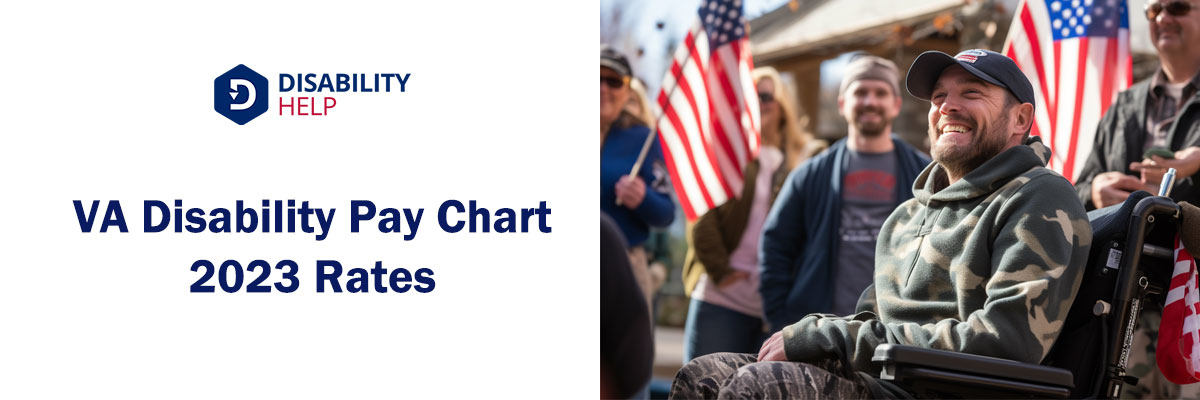There was a 5.9% increase in VA payments in 2023, the biggest increase in over 40 years.
The Veterans Benefits Administration (VBA) completed over 1.7 million disability compensation and pension claims for Veterans in 2022, a record-breaking number.[1]
The most common VA disability claims include tinnitus, limitation of flexion, knee, hearing loss, PTSD, and paralysis of the sciatic nerve.[2]
Effective by December 2023, there was a 3.2% increase for 2023 VA disability compensation.
VA disability benefits are analyzed annually by the US Department of Veterans Affairs. As a result of rising inflation and rising costs, the VA may determine that rates need to be adjusted based on economic trends.
There was a 5.9% increase in VA payments in 2023, the biggest increase in over 40 years. A high rate of inflation brought on by the pandemic caused the Cost of Living Adjustment (COLA) to increase by 5.9%. The Social Security Administration calculates the COLA annually.
Calculate your VA disability benefits and expected monthly payments using the charts on this page. In the following, we have cross-referenced all numbers with those released by the VA on December 1, 2021, and updated them accordingly.

2023 VA Disability Pay Chart
Fast Facts
In 2023, VA payments to beneficiaries increased by 5.9%, the largest increase in more than 40 years.
The Veterans Benefits Administration (VBA) completed over 1.7 million disability compensation and pension claims for Veterans in 2022, a record-breaking number.[1] But how exactly do you calculate your VA benefits?
You can use the following VA disability pay charts to calculate your VA disability compensation rates based on your marital status and the number of dependents you have.
| 10% – 20% (No Dependents) | |
| Percentage | Rates |
| 10% | $152.64 |
| 29% | $301.74 |
| 70% – 100% Without Children | ||||
| Dependent Status | 70% | 80% | 90% | 100% |
| Veteran Alone | $1,529.95 | $1,778.43 | $1,998.52 | $3,332.06 |
| Veteran with Spouse Only | $1,659.95 | $1,926.43 | $2,165.52 | $3,517.84 |
| Veteran with Spouse and One Parent | $1,763.95 | $2,045.43 | $2,299.52 | $3,666.94 |
| Veteran with Spouse and Two Parents | $1,867.95 | $2,164.43 | $2,433.52 | $3,816.04 |
| Veteran with One Parent | $1,633.95 | $1,897.43 | $2,132.52 | $3,481.16 |
| Veteran with Two Parents | $1,737.95 | $2,016.43 | $2,266.52 | $3,630.26 |
| Additional for A/A spouse | $119.00 | $136.00 | $153.00 | $170.38 |
| 30% – 60% With Children | ||||
| Dependent Status | 30% | 40% | 50% | 60% |
| Veteran with Child Only | $504.39 | $722.28 | $1020.44 | $1,288.03 |
| Veteran with Spouse and Child | $563.39 | $801.28 | $1,118.44 | $1,407.03 |
| Veteran with Spouse, One Parent and Child | $607.39 | $860.28 | $1,192.44 | $1,496.03 |
| Veteran with Spouse, Two Parents, and a Child | $651.39 | $919.28 | $1,266.44 | $1,585.03 |
| Veteran with One Parent and Child | $548.39 | $781.28 | $1,094.44 | $1,377.03 |
| Veteran with Two Parents and a Child | $592.39 | $840.28 | $1,168.44 | $1,466.03 |
| Add for Each Additional Child Under Age 18 | $27.00 | $36.00 | $46.00 | $55.00 |
| Each Additional Schoolchild Over Age 18 | $89.00 | $119.00 | $149.00 | $178.00 |
| Additional for A/A spouse | $51.00 | $68.00 | $86.00 | $102.00 |
| 70% – 100% With Children | ||||
| Dependent Status | 70% | 80% | 90% | 100% |
| Veteran with one Child (no spouse and no parents) | $1,615.95 | $1,877.43 | $2,109.52 | $3,456.30 |
| Veteran with Spouse and Child (no parents) | $1,754.95 | $2,035.43 | $2,287.52 | $3,653.89 |
| Veteran with Spouse, One Parent, and One Child | $1,858.95 | $2,154.43 | $2,421.52 | $3,802.99 |
| Veteran with Spouse, Two Parents, and a Child | $1,962.95 | $2,273.43 | $2,555.52 | $3,952.09 |
| Veteran with One Parent and Child | $1,719.95 | $1,996.43 | $2,243.52 | $3,605.40 |
| Veteran with Two Parents and a Child | $1,823.95 | $2,115.43 | $2,377.52 | $3,754.50 |
| Add for Each Additional Child Under Age 18 | $64.00 | $73.00 | $83.00 | $92.31 |
| Each Additional Schoolchild Over Age 18 | $208.00 | $238.00 | $268.00 | $298.18 |
| Additional for A/A spouse | $119.00 | $136.00 | $153.00 | $170.38 |
About 2023 VA Disability Compensation Rates
Veterans could receive VA disability compensation in 2022 if they sustained an illness or injury while serving in the military. It is a monthly tax-free payment from the Department of Veterans Affairs.
The most common VA disability claims include Tinnitus (rated at 10%), Limitation of Flexion, Knee (10%), Hearing Loss (0%), PTSD (70%), Lumbosacral or Cervical Strain (Back Pain) (10%), Paralysis of the Sciatic Nerve (10%), Scars, General (0%), Limitation of Range of Motion of the Ankle (10%), Limitation of Motion of the Arm (10%), and Migraines (Headaches) (30%).[2]
Fast Facts
In 2022, the Veterans Benefits Administration (VBA) processed over 1.7 million disability compensation and pension claims for Veterans.
It is also possible for veterans who developed service-connected disabilities after leaving service to claim benefits if those conditions had been exacerbated by their service. Furthermore, veterans with dependents, lost limbs or severe injuries, or a spouse who is disabled may receive additional benefits.
This benefit may be withdrawn anytime, and the end date may be changed. You may request a reexamination of a claim from the VA at any time if you believe your disability has improved or worsened. The VA can change its rating schedule and reexamine your benefit amount anytime. If they have a worse disability, you would want to begin the review yourself for them to receive a higher benefit.
How VA Disability Compensation is Determined
A VA disability compensation application must be submitted first. Benefits aren't guaranteed upon retirement, nor are they automatic. Once a veteran retires or within a specified amount of time after retiring, they are responsible for arranging an appointment with the VA.
According to the VA, your compensation depends on several factors, including your disability rating, how severe your disability is, and how many dependents you have.
The VA Disability Rating System Explained
Based on a scale of 0-100% and a rise of 10% incrementally, the VA uses a disability rating system to assess the severity of your disability. Depending on your rating, you will receive a certain amount of benefits. As part of determining your ratings, the VA will review a combination of service treatment records, VA medical records, and private medical records that directly relate to your disability to determine your rating.
Regardless of whether a condition meets multiple diagnostic codes, you will be rated based on a single diagnostic code per condition. Benefit amounts can be calculated using the combined-rating system if you have more than one disability.
The most common VA disability ratings by percentage are 100% and 10%. Of the 5,225,420 veterans with a service-connected VA rating, 18.45% have a combined rating of 100%, and 17.13% have a rating of 10%. The lowest overall combined VA rating is 0% (0.14% of recipients) followed by 50% (5.69% of recipients).[2]
Compensation for Service-Connected Disability
There are numerous types of service-related disabilities, such as chronic back pain, hearing impairments, tinnitus, post-traumatic stress disorder (PTSD), and traumatic brain injuries (TBI), which may not manifest until after active service is over, so veterans may not be eligible for disability compensation until after active service is over. If that is the case, it may be necessary to submit additional documentation on top of medical records to bolster your claim for disability compensation.
VA Disability Increase in 2024

The 2024 VA disability compensation rates were preliminarily confirmed on October 12, 2023, and are set to be finalized on December 1, 2023. This follows the SSA’s declaration of a 3.2% Cost of Living Adjustment (COLA) for the year 2024. Consequently, starting in January 2024, veterans will experience a 3.2% rise in their VA disability payments.
These updated rates for 2024 will take effect from December 1, 2023. Disabled veterans will notice the 3.2% COLA increment in their VA payments dated January 1, 2024. Veterans who have a VA disability rating of 10% or more will benefit from a 3.2% increase in their disability pay for the 2024 calendar year.
In 2024, there was a 3.2% increase in VA disability compensation. Refer to the accompanying table for a comparative overview of these adjustments spanning from 1976 to the present.
| VA Disability % | Effective Date | VA Disability % | Effective Date |
| 3.20% | Dec. 1 2023 | 2.10% | Dec. 1, 1997 |
| 8.70% | Dec. 1, 2022 | 2.90% | Dec. 1, 1996 |
| 5.90% | Dec. 1, 2021 | 2.60% | Dec. 1, 1995 |
| 1.30% | Dec. 1, 2020 | 2.80% | Dec. 1, 1994 |
| 1.60% | Dec. 1, 2019 | 2.60% | Dec. 1, 1993 |
| 2.80% | Dec. 1, 2018 | 3.00% | Dec. 1, 1992 |
| 2.00% | Dec. 1, 2017 | 3.70% | Dec. 1, 1991 |
| 0.30% | Dec. 1, 2016 | 5.40% | Dec. 1, 1990 |
| 0.00% | Dec. 1, 2015 | 4.70% | Dec. 1, 1989 |
| 1.70% | Dec. 1, 2014 | 4.00% | Dec. 1, 1988 |
| 1.50% | Dec. 1, 2013 | 4.20% | Dec. 1, 1987 |
| 1.70% | Dec. 1, 2012 | 1.30% | Dec. 1, 1986 |
| 3.60% | Dec. 1, 2011 | 3.10% | Dec. 1, 1985 |
| 0.00% | Dec. 1, 2010 | 3.50% | Dec. 1, 1984 |
| 0.00% | Dec. 1, 2009 | 3.50% | Dec. 1, 1983 |
| 5.80% | Dec. 1, 2008 | 7.40% | Oct. 1, 1982 |
| 2.30% | Dec. 1, 2007 | 11.20% | June 1, 1981 |
| 3.30% | Dec. 1, 2006 | 14.30% | June 1, 1981 |
| 4.10% | Dec. 1, 2005 | 9.90% | June 1, 1979 |
| 2.70% | Dec. 1, 2004 | 6.50% | Jan. 1, 1979 |
| 2.10% | Dec. 1, 2003 | 5.90% | Oct. 1, 1978 |
| 1.40% | Dec. 1, 2002 | 6.40% | Oct. 1, 1977 |
| 2.60% | Dec. 1, 2001 | 8.00% | Oct. 1, 1976 |
| 3.50% | Dec. 1, 2000 |
Assistance with Claims and Appeals
Veterans can file a claim or appeal and claim agents or Veterans Services Officers (VSOs). As qualified VA claim and appeals professionals, they are well-equipped to answer questions, meet your needs, and assist you in obtaining benefits.
Testimonials From VA Disability Beneficiaries
John, 34, Army Veteran
"I served in the Army for 12 years, and during a deployment in Afghanistan, I sustained a knee injury and developed PTSD. Adjusting to civilian life at 32 was tough, especially with my physical and mental health challenges. The VA disability payments have been a crucial support system.”
At 34 now, these payments help me manage my medical bills and provide for my young family. I've been able to enroll in a vocational training program, thanks to the financial stability they offer. This support means more than just money; it's about feeling valued and not forgotten."
Maria, 45, Navy Veteran
"I'm a 45-year-old Navy veteran who served for 15 years. My service left me with a chronic back injury and hearing loss. The transition back to civilian life was daunting, and the VA disability payments have been a cornerstone of my stability.
They cover my medical treatments, including physical therapy and hearing aids, and allow me to focus on my well-being. With this support, I've started a small business and am actively involved in the local veterans' community. It's not just the financial help; it's the recognition of my service that truly matters."
Alex, 52, Air Force Veteran
"After 20 years in the Air Force, retiring at 50 was bittersweet. I struggled with a service-related knee injury and anxiety. The VA disability payments have been a significant part of my life over the past two years. They help me afford my medical care and maintain a comfortable life.
At 52, I'm also using part of this support to fund my education in cybersecurity. This assistance is more than monetary aid; it's a reminder that my sacrifices for our country are acknowledged and appreciated."
Frequently Asked Questions
How is the disability rating determined?
Disability ratings are determined by the VA based on the severity of a veteran's service-connected condition. Ratings are given in 10% increments, ranging from 0% to 100%.
Does the VA disability rate change annually?
Yes, VA disability rates are typically adjusted each year to reflect changes in the cost of living. This adjustment is based on the Cost of Living Adjustment (COLA) set by the Social Security Administration.
Can veterans with a 0% disability rating receive compensation?
Veterans with a 0% disability rating are recognized as having a service-connected condition but typically do not receive monthly compensation. However, they may be eligible for other benefits.
How does having dependents affect VA disability pay?
Veterans with higher disability ratings (usually 30% or higher) are eligible for additional compensation for dependents, which may include a spouse, children, or dependent parents.
What if my disability worsens over time?
If your service-connected disability worsens, you can file for an increased disability rating with the VA. If approved, your compensation will be adjusted according to the new rating.
Conclusion
Understanding the 2023 VA Disability Pay Chart is crucial for veterans seeking to maximize their benefits. As inflation and economic trends affect the rates, staying informed ensures they are adequately compensated. By leveraging resources, veterans can successfully navigate these adjustments, asserting their rights and accessing their due benefits.
Applying for cash benefits from Social Security can seem overwhelming for some people. Check out our guide on how to increase your VA disability rating. To help you prepare for VA disability claims, do your research as well. Visit the Disability Help blog for more information.
- “Veterans Benefits Administration Reports,” U.S. Department of Veterans Affairs, 2023, https://www.benefits.va.gov/REPORTS/detailed_claims_data.asp
- “The Most Common VA Disability Ratings,” VA Claims Insider, 2023, https://vaclaimsinsider.com/most-common-va-disability-ratings/





